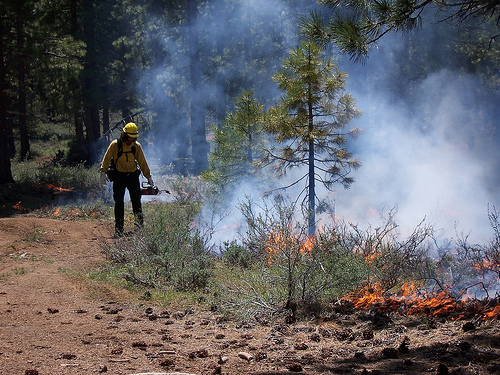Prescribed burns can aid in efforts to reduce severity of wildfires
Forest fires have a tendency to evoke images of Smoky the Bear warnings or Bambi and company fleeing for their lives. However, often underreported are the benefits prescribed forest fires can have on ecosystems and human communities.
This summer, the Ecological Society of America (ESA) published its first online-only special issue of Frontiers in Ecology and the Environment, which examined the impacts of prescribed burning in North America in addition to several other locations around the world. Prescribed burns are meant to mimic the impact of natural fires, caused by lightning, or the smaller intentional fires traditionally produced by Native Americans.
In the last century, fire suppression activities have focused on the protection of property and keeping parks pretty, dramatically diminishing fire frequency throughout the West. As a consequence, ecosystems change. Species that evolved with fire lose their competitive edge. Dense growth fills the forest understory, savannas become forests, and brush clogs grasslands. When forest fires do occur, they are often more intense, more damaging and more costly to mitigate, thanks to the extra fuel.
Prescribed burns reduce fire intensity by reducing tree density in a forest ecosystem. Prescribed burns also curtail the proliferation of fire-sensitive species, helping to promote species diversity in an ecosystem.
In the most recent edition of the Ecologist Goes to Washington podcast, ESA Rapid Response Team member Matthew Hurteau discusses his  research on wildfires. Hurteau’s research focuses on the various ways in which climate change exacerbates fire risk, due to warming temperatures and longer more frequent droughts. Hurteau explained the benefits of prescribed burns during a visit with policymakers on Capitol Hill.
research on wildfires. Hurteau’s research focuses on the various ways in which climate change exacerbates fire risk, due to warming temperatures and longer more frequent droughts. Hurteau explained the benefits of prescribed burns during a visit with policymakers on Capitol Hill.
For much of the past ten years, the US Forest Service has had to borrow from other agency accounts in order to cover expenses of mitigating wildfires, which have increased in frequency in recent years. According to testimony before Congress from USFS Chief Tom Tidwell, fire suppression activities as a share of the agency’s total budget has burgeoned from 13 percent in Fiscal Year (FY) 1991 to 40 percent in FY 2012.
Given the demonstrated capability of prescribed burns to reduce the risk, and consequently the costly damage, of severe wildfires, implementing such ecologically friendly practices nationwide could not only help save lives and protect natural resources, but also help key natural resource agencies stay on budget.
Photo Credit: Steve McKelvey: US Forest Service
